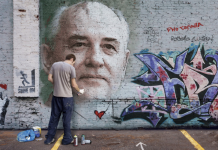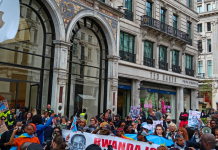Lois JC (Brixton) reviews the Tate Modern’s new show
Malevich: Revolutionary of Russian Art at the Tate Modern is the first retrospective of the Russian avant garde artist Kazimir Malevich (1879-1935) in 25 years.
The exhibition illustrates, beautifully yet subtly, the contours of a time of revolutionary upheaval: from his early influences and the formation of Russian Modernism, through the desire to formulate a new world from 1917, and on to alienation under Stalin.
It raises questions about the role art can play, and did play, within the political and social context of its times, and it does so with understated clarity.
Confrontation and new birth
Malevich grew up as a Roman Catholic in Kiev. He fused Russian religious references with techniques being pioneered by artists across Europe at the time.
In The Scyther (1912) we see a farmworker paired with futurism. He looks like he was made in a factory. This was not simply a fusion of worlds but the formation of a new language and new way of doing art.
Other works used Cubist techniques but with colours and tones from traditional Russian art. Malevich called this “Cubo-Futurism”. Paintings display a world scrambled up. The world as he knew it was still visible, but it had changed.
Themes of confrontation alongside new birth run through the exhibition. In works Malevich called “alogical art” we see forms with unclear links positioned together, such as 1913’s Cow and Violin.
He wrote that year: “Logic has almost created a barrier to movements… Alogical painting represents moments of struggle through the confrontation of two forms.”
Suprematism: against nature and narrative
At the centre of the show is Malevich’s attempt to introduce and define Suprematism – a new approach to art that rejected direct attempts to visualise reality. Artwork should be abstracted from nature or narrative to focus upon pure form and colour. An artist only becomes a creator when their work steps away from the natural world.
Tate curator Achim Borchardt-Hume has carefully reconstructed Malevich’s 0.10 exhibition, held in Petrograd 1915, from the only existing photograph of the show.
Malevich’s ten paintings were positioned around the room in an entirely new way. Black Quadrilateral was placed in the top corner – the traditional place for a domestic icon.
Russia’s avant garde artists generally welcomed the revolution – not because they were necessarily that left wing, but often due to the parallels between creating a new artwork and creating the new world.
For Malevich, Suprematicsm was about taking the idea of a new art to extremes. 1921’s White Suprematist Cross (a rather unfortunate name today) takes reduction a step further still, removing colour in the quest for pure form.
Shortly after 1917 Malevich gave up painting altogether, feeling that it had reached an end point as a form of art. He turned to architectural designs and joined a utopian art collective called UNOVIS to spread and explain Suprematist ideas.
Malevich and the collective designed new things for a new world. But often they would come up against the material constraints of that world. One exhibit shows a set of ordinary plates, teapots and cups with Suprematist designs painted on them. The artists did not have the resources to completely redesign the object.
Stalin and the realist backlash
In 1928 Stalin started his first Five Year Plan – and Russian avant garde art was condemned as elitist. Malevich resumed painting during this time, returning to figurative work with rural Russian themes.
But this was not a simple return to his early work: the colours and forms of Suprematism are still visible. And the faceless mannequins pictured labouring reflect a new sense of alienation in a period of forced collectivisation and mass starvation.
Malevich was twice arrested for espionage by Stalin. On his second release in 1930 he made the following statement: “I never shared the views of the bourgeoisie world in art and never belonged to any right wing currents. In Germany I was referred to as the Bolshevik who has arrived. I have been working for the benefits of Soviet art – I come from a workers family and became known on my own efforts.”
Some say this later work is simply a capitulation to Stalin. But there are subtle references to the new world’s failure to be properly born.
Woman Worker, from 1933, looks like a traditional portrait at first glance. But the clothes portrayed are more like the costume he designed for a 1913 opera, Victory Over The Sun, than traditional peasant wear. He signed his pictures throughout this time with a little black square as a rebellious nod to his Suprematist days.
Did painting die?
“Painting died, like the old regime,” wrote Malevich in 1919. But his ideas for what would replace painting – architecture, design, taking art to the people – were never fully realised. Utopian projects stumbled at the hurdle of implementation as the political landscape changed.
But even if painting did not die, it had been changed forever. The old world had not been destroyed completely, but some kind of new art had undoubtedly emerged. Malevich’s incomplete work poses puzzles that still challenge us today.
â–º Malevich: Revolutionary of Russian Art runs at Tate Modern, London, until 26 October. Tickets cos £14.50 or £12.50 for concessions.


























